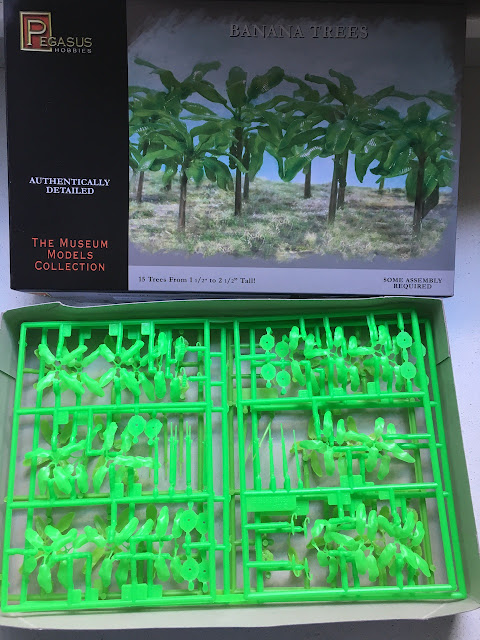I painted the leaves Tamiya acrylic Yellow Green on their outer edges and filled in the inner parts with Tamiya Flat Green. The dying leaves around the top of the trunk and the trunks themselves were painted Tamiya Flat Earth. They were then dry brushed with Vallejo Tan Yellow and highlighted with a brush of Vallejo Dark Sand. The trunks were dry brushed with Vallejo Sky Grey. I plan to base them on MDF 150mmx50mm strips that will hold two trees each. This will allow me to set up the plantations but also move trees during play.
Given palm plantations are in orderly rows I've mounted two trees to a base. They can be a bit top heavy and so a larger base ensures they are much less likely to be knocked over, but it also helps in having the trees look like they've been planted in rows.
Here they are in use in the first game of the Chain of Command Last Stand on Opium Hill.
I gave a very similar paint treatment to the smaller Pegasus banana trees. These are made of a fairly brittle plastic and will not be as hardy as the palm trees when it comes to gaming. I decided to base these as I have my orchard trees by putting three on strips of MDF so they can be moved in different directions to allow the placement of miniatures.
The bases were then textured with sand and PVA.
The next job was to take to all of these with the airbrush and give them a green colour that will blend them all together with other jungle terrain. Once again I used Tamiya acrylics, Flat Green and Yellow Green and this toned down a lot of the colour. The bases were painted using Dulux emulsion sample pots with my usual earth colour - a base of Deep Bamboo and a dry brush of Arava.
The bases were then textured with sand and PVA.
The next job was to take to all of these with the airbrush and give them a green colour that will blend them all together with other jungle terrain. Once again I used Tamiya acrylics, Flat Green and Yellow Green and this toned down a lot of the colour. The bases were painted using Dulux emulsion sample pots with my usual earth colour - a base of Deep Bamboo and a dry brush of Arava.















Really nice work.
ReplyDeletecheers John
Awesome palm painting.
ReplyDeleteyou could also use the aquarium grass as Agave and paint them grey green, if you playing in an Americas theatre.
ReplyDeleteAwesome painting by the way. Forgot to add that. :)
ReplyDeleteHave just received some plastic terrain from China and painted up one of the palm trees using your instructions, thanks for sharing the information Mark.
ReplyDeletecheers John
I’m assuming this is all part of your preparation for Cancon next year? Looking forward to seeing everything you come up with and glad I could be of some service!
DeleteJust discovered your blog. And may I say, for a 20mm Battlegroup gamer like myself, it's amazing stuff.
DeleteI did jungle pieces done on CD-ROMs, I doubt mine are better than yours, in fact, pretty sure they are not...but all in all, nice work!
Thank you, glad you’re enjoying the blog. Good to see you’ve found a use for all those redundant CD-ROMs! 20mm is the perfect scale for WW2 in my opinion, it hits the sweet spot.
Delete